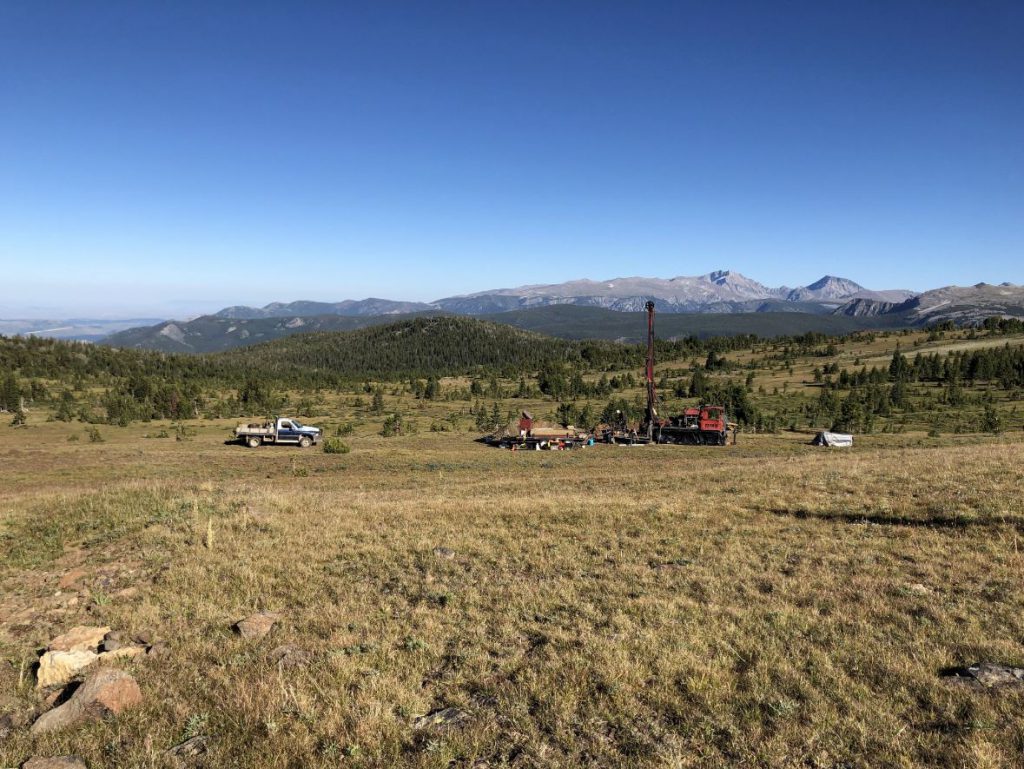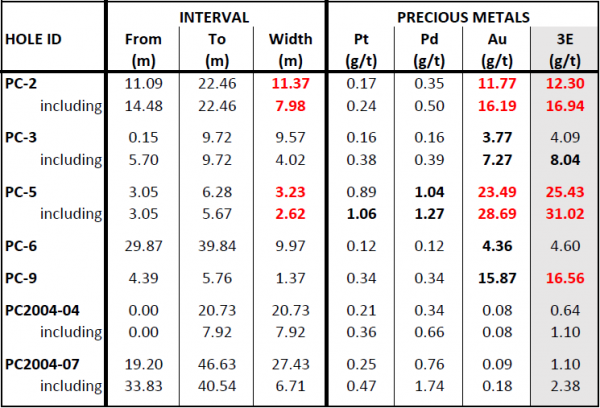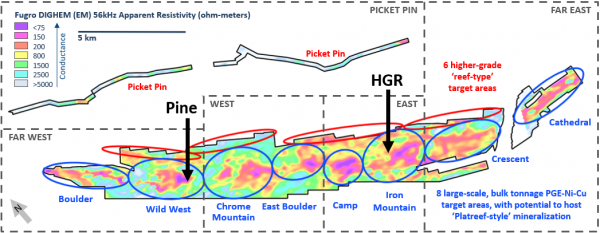Group Ten Reports High-Grade Gold, Palladium, and Platinum Results from the Pine and HGR Targets at the Stillwater West Project in Montana, USA

This is the fifth in a series of planned news releases to report results of exploration programs that focused on the advancement of drill-defined mineralized zones at five multi-kilometer-scale priority target areas. Subsequent news releases will report results from ongoing modelling work and rhodium assays from drill and field samples prior to our 2020 field exploration programs.
Highlights include:
- The Pine target shows very high-grade gold, palladium and platinum mineralization in drilling, soils and rock sampling that is now being further assessed by the Company.
- Drilling at the Pine target returned values including 16.94 g/t 3E (16.19 g/t Au, 0.24 g/t Pt, 0.50 g/t Pd) over 7.98 meters and 31.02 g/t 3E (28.7 g/t Au, 1.06 g/t Pt, 1.27 g/t Pd) over 2.6 meters hosted within the chromite-rich ultramafic stratigraphy.
- High-grade gold, palladium, and platinum values ranging to 16.18 g/t 3E (13.80 g/t Au, 1.10 g/t Pd, and 1.28 g/t Pt) were returned in rock samples taken by Group Ten in 2019 at the Pine target, with a total of 13 samples returning from 2 to 30 g/t platinum equivalent grade mineralization to date by the Company.
- At the HGR target, nine kilometers east of the Pine target, high-grade gold, palladium, and platinum values ranging to 19.06 g/t 3E (14.30 g/t Au, 3.10 g/t Pd, and 1.66 g/t Pt) were returned in assays conducted by the US Geological Survey (“USGS”) on select samples of historic drill core from the HGR target area at Iron Mountain that had not previously been assayed for precious metals
- Results have identified a “gold suite” of pathfinder elements that co-occur in high-grade samples.
Michael Rowley, President and CEO, commented, “Our systematic approach in consolidating and exploring the famously metal-rich yet underexplored Stillwater district continues to proffer exciting and unexpected revelations. Our collaboration with the US Geological Survey has revealed that core drilled in 1977 at the HGR target contains high-grade gold, palladium, and platinum that were not previously recognized, and that are comparable to grades seen at the Pine target on the western side of the district. Â In addition, we have identified geological similarities, including a suite of pathfinder elements that occur together in both locations, that provide a guide for targeting gold-rich mineralization across the 25-kilometer-wide property. These high-grade gold zones are now being recognized to be much more broadly distributed and to occur within some of the same horizons that host the bulk-tonnage “Platreef-style” deposits of palladium, platinum, gold, rhodium, nickel, copper, and cobalt in the lower Stillwater complex. We look forward to providing further news including additional exploration results, updates on modelling work at the most advanced target areas, ahead of field exploration in 2020.”
Gold Suite Program and Results
A total of 40 samples were assayed from the HGR and Pine targets, which are two of the five most advanced target areas at Stillwater West (see Figure 1). Samples from the Pine target consisted of rock chip samples gathered by Group Ten in 2019, while the HGR samples consisted of select intervals of chromite-sulphide bearing bronzite cumulate core retained by the USGS from hole 355-71, originally drilled by AMAX in 1977 but only partially assayed at that time. Results from HGR core assays by the USGS demonstrate high-grade gold values in addition to platinum, palladium, nickel, arsenic, bismuth, and antimony (see Table 1).
The HGR target was tested by Group Ten in 2019 with three drill holes, with hole IM2019-2 testing the area near historical AMAX hole 355-71 (see December 18, 2019 news release). Sulphide-bearing bronzite cumulate intercepted in IM2019-2 over a 14-meter interval from 114 to 128 meters depth, broadly corresponding to the 355-71 interval tested by the USGS, returned highly anomalous concentrations of the same distinct metal suite seen in 355-71, including gold, platinum, palladium, arsenic and bismuth.
TABLE 1 – High-Au samples from AMAX drill hole 355-71, HGR Target (Bow et al., 2020)1

The Pine target, situated approximately nine kilometers to the west of Iron Mountain, has been recognized as an occurrence of high-grade gold-PGE mineralization associated with sheared, chromite-bearing ultramafic rocks. It is one of five advanced target areas where the Company sees the potential to quickly establish preliminary mineral resource estimates, with seven drill holes from 1983 and 2004 that define a precious metals-rich mineralized zone that is 150 meters strike with an average width of 15 meters that has been tested to a depth of 90 meters (see Table 2 and Figure 7 below, and news releases from June 4, 2019, January 25, 2019, and May 13, 2020).
TABLE 2 – Pine Target Drill Results

Rock chip samples taken from rubble crop near historical drill holes has confirmed the presence of high-grade gold values. As shown in Table 3, assay results returned elevated values of arsenic and bismuth, suggesting a geochemical affinity with the HGR drill holes and confirming the presence of unusual concentrations of arsenic and bismuth associated with gold-rich samples from widely spaced targets within the Stillwater West property.
TABLE 3 – High-Grade Gold Results from 2019 Rock Samples, Pine Target

Dr. Craig Bow, Chief Geologist, commented, “This additional geochemical data for gold-rich samples gives us a clearer sense of the distinctive geochemistry of these rocks. In addition to arsenic and bismuth, we also see elevated values of antimony and tellurium, which are extremely unusual in bulk rock assays from elsewhere in the Stillwater Igneous Complex. The fact that we now have two examples from widely spaced locations in the Peridotite Zone suggests that a bona fide, previously unrecognized gold-enriched style of mineralization can occur along with bulk tonnage PGE-Ni-Cu-Co targets.”
As announced May 13, 2020 and summarized in Figures 2, 3, and 4, work in 2019 significantly expanded the area of highly anomalous gold, palladium, and platinum in soils and advanced the developing block model by re-logging and re-assaying drill core from 2004.
Mineralization at the Pine and HGR targets remains open to expansion in all directions.
FIGURE 1 – Main Target Areas Including Location of the Pine and HGR Targets Across the 25-Kilometer Width of the Stillwater West Project

About Stillwater West
The Stillwater West PGE-Ni-Cu project positions Group Ten as the second-largest landholder in the Stillwater Complex, adjoining and adjacent to Sibanye-Stillwater’s Stillwater, East Boulder, and Blitz platinum group elements (“PGE”) mines in south-central Montana, USA1. The Stillwater Complex is recognized as one of the top regions in the world for PGE-Ni-Cu mineralization, alongside the Bushveld Complex and Great Dyke in southern Africa, which are similar layered intrusions. The J-M Reef, and other PGE-enriched sulphide horizons in the Stillwater Complex, share many similarities with the highly prolific Merensky and UG2 Reefs in the Bushveld Complex. At the same time, the lower part of the Stillwater Complex also shows the potential for much larger scale disseminated and high-sulphide PGE-Ni-Cu deposits, similar to Platreef in the Bushveld Complex2. Group Ten’s Stillwater West property covers the lower part of the Stillwater Complex along with the Picket Pin PGE Reef-type deposit in the upper portion, and includes extensive historic data, including soil and rock geochemistry, geophysical surveys, geologic mapping, and historic drilling.
About Group Ten Metals Inc.
Group Ten Metals Inc. is a TSX-V-listed Canadian mineral exploration company focused on the development of high-quality platinum, palladium, nickel, copper, cobalt, and gold exploration assets in top North American mining jurisdictions. The Company’s core asset is the Stillwater West PGE-Ni-Cu project adjacent to Sibanye-Stillwater’s high-grade PGE mines in Montana, USA2. Group Ten also holds the high-grade Black Lake-Drayton Gold project in the Rainy River district of northwest Ontario and the Kluane PGE-Ni-Cu project on trend with Nickel Creek Platinum‘s Wellgreen deposit in Canada‘s Yukon Territory.
About the Metallic Group of Companies
The Metallic Group is a collaboration of leading precious and base metals exploration companies, with a portfolio of large, brownfield assets in established mining districts adjacent to some of the industry’s highest-grade producers of silver and gold, platinum and palladium, and copper. Member companies include Metallic Minerals in the Yukon’s high-grade Keno Hill silver district and La Plata silver-gold-copper district of Colorado, Group Ten Metals in the Stillwater PGM-nickel-copper district of Montana, and Granite Creek Copper in the Yukon’s Minto copper district. The founders and team members of the Metallic Group include highly successful explorationists formerly with some of the industry’s leading explorers/developers and major producers. With this expertise, the companies are undertaking a systematic approach to exploration using new models and technologies to facilitate discoveries in these proven, but under-explored, mining districts. The Metallic Group is headquartered in Vancouver, BC, Canada, and its member companies are listed on the Toronto Venture, US OTC, and Frankfurt stock exchanges.
Note 1: Bow, C.S., Ostenson, M., Modroo, J.J. and Andersen, A., 2020.  Precious and Base Metal Mineralization Within the Lower Stratigraphy of the Stillwater Complex: New Targets Defined and Old Targets Revisited. Geological Society of Nevada Symposium Proceedings, in prep. References to adjoining properties are for illustrative purposes only and are not necessarily indicative of the exploration potential, extent or nature of mineralization or potential future results of the Company’s projects.
Note 2: References to adjoining properties are for illustrative purposes only and are not necessarily indicative of the exploration potential, extent or nature of mineralization or potential future results of the Company’s projects.
FOR FURTHER INFORMATION, PLEASE CONTACT:
Michael Rowley, President, CEO & Director
Email: info@grouptenmetals.com            Phone: (604) 357 4790
Web: http://grouptenmetals.com            Toll Free: (888) 432 0075
Quality Control and Quality Assurance
2019 field samples were analyzed by ACT Labs in Vancouver, B.C. Sample preparation: crush (< 7 kg) up to 80% passing 2 mm, riffle split (250 g) and pulverize (mild steel) to 95% passing 105 µm included cleaner sand. Gold, platinum, and palladium were analyzed by fire assay (1C-OES) with ICP finish. Selected major and trace elements were analyzed by peroxide fusion with 8-Peroxide ICP-OES finish to insure complete dissolution of resistate minerals.
Mr. Mike Ostenson, P.Geo., is the qualified person for the purposes of National Instrument 43-101, and he has reviewed and approved the technical disclosure contained in this news release.
Forward-Looking Statements
Forward Looking Statements: This news release includes certain statements that may be deemed “forward-looking statements”. All statements in this release, other than statements of historical facts including, without limitation, statements regarding potential mineralization, historic production, estimation of mineral resources, the realization of mineral resource estimates, interpretation of prior exploration and potential exploration results, the timing and success of exploration activities generally, the timing and results of future resource estimates, permitting time lines, metal prices and currency exchange rates, availability of capital, government regulation of exploration operations, environmental risks, reclamation, title, and future plans and objectives of the company are forward-looking statements that involve various risks and uncertainties. Although Group Ten believes the expectations expressed in such forward-looking statements are based on reasonable assumptions, such statements are not guarantees of future performance and actual results or developments may differ materially from those in the forward-looking statements. Forward-looking statements are based on a number of material factors and assumptions. Factors that could cause actual results to differ materially from those in forward-looking statements include failure to obtain necessary approvals, unsuccessful exploration results, changes in project parameters as plans continue to be refined, results of future resource estimates, future metal prices, availability of capital and financing on acceptable terms, general economic, market or business conditions, risks associated with regulatory changes, defects in title, availability of personnel, materials and equipment on a timely basis, accidents or equipment breakdowns, uninsured risks, delays in receiving government approvals, unanticipated environmental impacts on operations and costs to remedy same, and other exploration or other risks detailed herein and from time to time in the filings made by the companies with securities regulators. Readers are cautioned that mineral resources that are not mineral reserves do not have demonstrated economic viability. Mineral exploration and development of mines is an inherently risky business. Accordingly, the actual events may differ materially from those projected in the forward-looking statements. For more information on Group Ten and the risks and challenges of their businesses, investors should review their annual filings that are available at www.sedar.com.
Neither the TSX Venture Exchange nor its Regulation Services Provider (as that term is defined in the policies of the TSX Venture Exchange) accepts responsibility for the adequacy or accuracy of this release.
